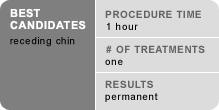Getting Started with Cheek Enhancement
Surgery may be performed in an office surgical suite, outpatient surgery center, or hospital. Time in surgery is about 30 minutes to one hour. The procedure may be performed under local anesthesia (awake, but sedated) or general anesthesia (asleep). You can discuss the appropriate type of anesthesia with Dr. Hart and the anesthesiologist.
Typically, you can return home the same day, though sometimes an overnight stay at the hospital is needed.
The facial implant procedure varies depending on the type of implant. The most common facial implants are chin, cheek, or jaw implants. You may need more than one type of implant to achieve the results you're looking for.
Cheek Implant Procedure
During a cheek implant procedure, an incision will be made under the lower eyelid or on either side of the upper lip. Dr. Hart will create a pocket for the implant to fit into, then insert the implant through the incision. A bandage will be applied to reduce swelling and discomfort.
Cheek Implant Recovery
Moving your mouth, eyes, and lips may be difficult during recovery. Dr. Hart will instruct you to limit activity and set dietary guidelines.
Alternative and Additional Treatments
Facial implant surgery is one of the many cosmetic-surgery remedies to improve faces affected by aging or genetic issues. Temporary, less invasive alternatives include Botox, fat fillers, collagen and Restylane.
You may want to incorporate facial implants with other plastic surgery procedures. For example, facial implant surgery can enhance the results of a facelift. It may also be performed at the same time as a forehead lift or eyelid surgery. Successful strategies often include a combination treatment plan developed by Dr. Hart customized for each individual.


